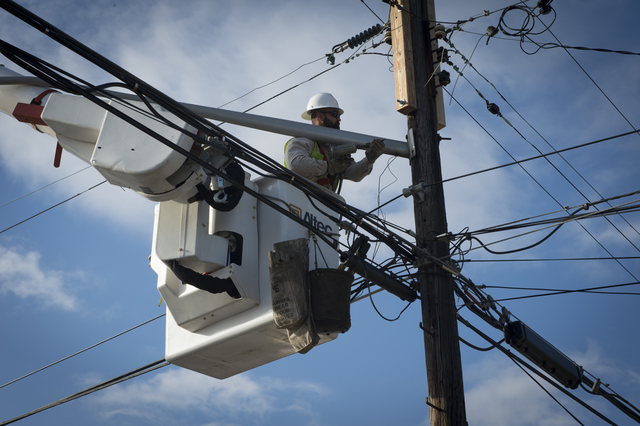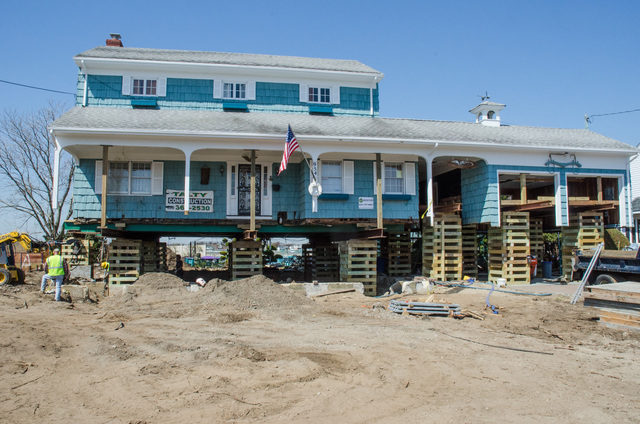Disaster recovery is as much about building a stronger future as it is about repairing past damage. In this section you will find information about Hurricane Sandy recovery in Region II, including key metrics on assistance, funding and progress.
Hurricane Sandy: Assistance
In October 2012, Hurricane Sandy struck the northeast coast of the United States and damaged hundreds of thousands of homes, forced tens of thousands of survivors into shelters and caused billions of dollars in damage to vital infrastructure systems including power transmission, transportation and water and sewage treatment facilities.
FEMA continues to collaborate with local, state and federal partners, as well as voluntary agencies and the private sector, to help individuals, families, businesses and communities recover from the storm. Recovery efforts include projects to restore vital infrastructure, public facilities and services, rehabilitation and reconstruction of private and commercial properties, and restoration of the economic base.
Coordination efforts among multiple supporting federal agencies continue, ensuring impacted New Jersey and New York communities do not only repair damage, but become stronger, more resilient and better able to withstand future disasters.
New Jersey Three Years After Sandy: Recovery Milestones
New York Three Years After Sandy: Recovery Milestones
Sandy Recovery in Region II: By the Numbers
As of Sept. 26, 2016, the Federal Emergency Management Agency has provided nearly $25 billion in total funding to applicants in New Jersey and New York.
Assistance in Region II | Amount* |
|---|---|
| Assistance to disaster survivors (Individual Assistance) | $1.4 billion |
| Assistance to state, local and tribal governments (Public Assistance), including mitigation assistance. | $14.6 billion |
| Hazard Mitigation Grant Program | $966.4 million |
| National Flood Insurance Program | $8 billion |
| Total | ~ $25 billion |
* Represents FEMA funding in New Jersey and New York combined.
Assistance to Individuals and Households
 FEMA’s Individuals and Households Program disbursed $1.4 billion to 179,016 individuals and households impacted by Sandy in New Jersey and New York. More than $1.2 billion of this was dedicated to housing assistance, including costs for temporary housing, repair or replacement of eligible damaged property, and other disaster-related expenses not covered by homeowner’s or renter’s insurance.
FEMA’s Individuals and Households Program disbursed $1.4 billion to 179,016 individuals and households impacted by Sandy in New Jersey and New York. More than $1.2 billion of this was dedicated to housing assistance, including costs for temporary housing, repair or replacement of eligible damaged property, and other disaster-related expenses not covered by homeowner’s or renter’s insurance.
Public Assistance
 FEMA’s Public Assistance Program provides grants to state, local and tribal governments and certain private nonprofit organizations to assist with disaster response and recovery, including debris removal, emergency protective measures and permanent restoration of public facilities and critical infrastructure. About $14.6 billion has been obligated to date for Public Assistance projects in Region II. This includes mitigation funding to ensure New Jersey and New York build back stronger and more resilient.
FEMA’s Public Assistance Program provides grants to state, local and tribal governments and certain private nonprofit organizations to assist with disaster response and recovery, including debris removal, emergency protective measures and permanent restoration of public facilities and critical infrastructure. About $14.6 billion has been obligated to date for Public Assistance projects in Region II. This includes mitigation funding to ensure New Jersey and New York build back stronger and more resilient.
Mitigation
 FEMA’s Hazard Mitigation Grant Program (HMGP) provides grants to states and local governments to implement long-term hazard mitigation measures after a major disaster declaration. The purpose of the HMGP is to proactively reduce the loss of life and property from future disasters by promoting mitigation measures during a disaster recovery. The program is administered by the state and funded by FEMA. To date, about $966 million has been awarded for mitigation projects in Region II.
FEMA’s Hazard Mitigation Grant Program (HMGP) provides grants to states and local governments to implement long-term hazard mitigation measures after a major disaster declaration. The purpose of the HMGP is to proactively reduce the loss of life and property from future disasters by promoting mitigation measures during a disaster recovery. The program is administered by the state and funded by FEMA. To date, about $966 million has been awarded for mitigation projects in Region II.
Sandy Recovery Improvement Act of 2013
On January 29, 2013, President Barack Obama signed into law the Sandy Recovery Improvement Act (SRIA) of 2013 and the accompanying Disaster Relief Appropriations Act, 2013. In many ways, the passage of SRIA represents the most significant legislative change to the Federal Emergency Management Agency’s (FEMA) substantive authorities since the enactment of the Robert T. Stafford Disaster Relief and Emergency Assistance Act.
An overview of the provisions of the Sandy Recovery Improvement Act (SRIA) of 2013, as well as the status of FEMA's implementation, describes how the law authorizes key changes in the way FEMA may deliver federal disaster assistance to survivors.
In accordance with the SRIA, FEMA provides updated Mission Assignments and Public Assistance Grant Awards activity.
The NY/NJ Federal Leadership Resilience Collaborative
Hurricane Sandy recovery catalyzed a transformation in the federal government’s approach to rebuilding, particularly infrastructure. The Sandy Regional Infrastructure Resilience Coordination group created an interagency coordination process whereby all levels of government collaborate on infrastructure resilience. This is known as the New York/New Jersey Collaborative.
Regional Administrators and other senior staff from the regional offices of the Federal Emergency Management Agency, the Department of the Interior, the Department of Transportation, the Environmental Protection Agency, the Department of Housing and Urban Development and the U.S. Army Corps of Engineers coordinate key infrastructure projects to identify synergies and potential conflicts, promote regional resiliency, improve efficiencies and maximize the impact of taxpayer dollars.
This allows for a shared understanding among federal agencies of their respective disaster recovery programs and provides opportunities for better leveraging of dollars, avoids duplication of work and fosters a comprehensive region-wide approach to risk reduction.integrate infrastructure goals throughout New Jersey and New York. This high-level interagency coordination has resulted in, among other achievements, a comprehensive database of all six agencies’ projects, allowing Collaborative members to drill down to the community and even neighborhood level, examining intersections and gaps among more than 500 Sandy-related projects with a combined value of $40 billion in federal investment.
Separately, groups of interdisciplinary technical experts from these and other partner agencies review project scopes and specifications to streamline federal review and permitting processes and expedite completion timelines.
The Collaborative’s future focuses on enhancing information-sharing at the operational and staff level and aligning the risk-reduction strategic vision of the federal family with states, tribes and local authorities to increase resiliency.
Partners in Sandy Recovery
 New Jersey Office of the Governor
New Jersey Office of the Governor
 New Jersey Office of Emergency Management
New Jersey Office of Emergency Management
 New York Office of the Governor
New York Office of the Governor
 New York Governor’s Office of Storm Recovery
New York Governor’s Office of Storm Recovery
 New York State Division of Homeland Security and Emergency
New York State Division of Homeland Security and Emergency
 Department of Health & Human Services
Department of Health & Human Services
 United States Department of Agriculture
United States Department of Agriculture
 Environmental Protection Agency
Environmental Protection Agency
Photos, Videos, Articles
Visit the FEMA Multimedia Library to browse photos, videos and audio of Sandy response and recovery.
Long Beach Public Schools. Many public were schools were either damaged or destroyed in Long Beach, Long Island. In this video, learn how mitigation advice and funding from the FEMA Public Assistance program helped paved the way for schools to reopen.
NYU Langone Medical Center. NYU Langone Medical Center, located 200 feet from New York City's East River, suffered severe flood damage during Hurricane Sandy. In this video, learn how NYU Langone staff worked with FEMA to mitigate against future flooding.
New Jersey’s Liberty State Park. At the heart of the park is the Central Railroad of New Jersey Terminal. Immigrants processed through Ellis Island would board trains at this terminal to find new homes throughout the United States. In this video, learn how FEMA Environmental Planning and Historic Preservation specialists are involved in helping to restore this historic structure, which was badly damaged by Hurricane Sandy.
Asbury Park, N.J. Assisted by FEMA funding, the town was one of the first Jersey Shore communities able to welcome visitors back after Hurricane Sandy. In this video, watch town officials cut the ribbon on their restored boardwalk.
Accessibility and Housing Elevation. During Hurricane Sandy recovery, many homeowners were faced with the decision to elevate their homes to prevent potential damage in future flood events. Living in an elevated home presents challenges for anyone but is especially difficult for people with disabilities. In this video, learn about the use of “universal design” in planning private and public spaces to accommodate anyone with or without a disability
Sandy Success Stories. Read how several organizations worked closely with FEMA staff to help recover from Sandy and how they incorporated mitigation measures to protect against future damage.
The following images reflect how state, local and federal partners continue to help New Jersey and New York rebuild smarter and stronger.




Disability Integration in Disaster Response and Recovery
Learn about FEMA’s commitment to disability integration in disaster response and recovery:
Disability Integration. FEMA’s Office of Disability Integration and Coordination leads FEMA’s commitment to achieve whole community emergency management, inclusive of individuals with disabilities. Disability Integration Specialists provide guidance, training and tools for facilitating disability-inclusive emergency preparedness, response, recovery and mitigation. At the regional level, Disability Integration Specialists work closely with the states to ensure that disaster planning is inclusive of people with disabilities and others with access and functional needs. Simultaneously, they work with local nonprofit disability groups to reach the disability community, encouraging them to participate in federal, state, local, and community emergency planning meetings. FEMA supports the development of advisory groups led by representatives from disability services and advocacy organizations alongside emergency managers to facilitate stakeholder engagement.
Accessibility and Housing Elevation Video. During Hurricane Sandy recovery, many homeowners were faced with the decision to elevate their homes to prevent potential damage in future flood events. Living in an elevated home presents challenges for anyone but is especially difficult for people with disabilities. Disability advocates promote the use of “universal design” in planning private and public spaces to accommodate anyone with or without a disability.
Working Together to Assist Disaster Survivors depicts the relationship and partnership between Disaster Survivor Assistance and Disability Integration.
Accessible Housing Recovery Resource. This document provides information and guidance on housing programs, technical and legal support services and additional federal, state and city resources to support Sandy survivors in New York.
Media
Sandy news releases: New Jersey, New York
Track FEMA projects and spending
Explore data visualizations of FEMA activity
Resources
Learn about flood insurance, flood risks, resources and how to file claims:






 Department of Transportation
Department of Transportation